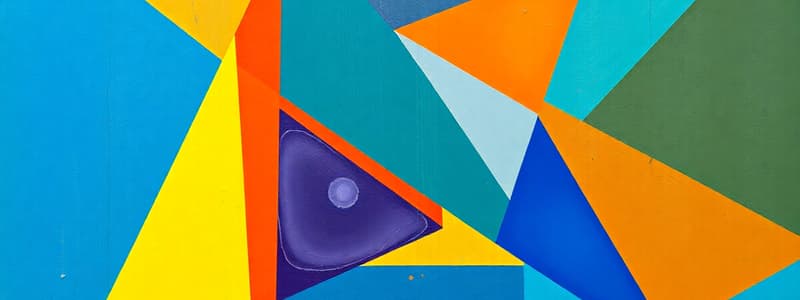Podcast
Questions and Answers
Which of the following sets of side lengths can form a triangle?
Which of the following sets of side lengths can form a triangle?
- 9, 12, 18
- 14, 14, 19 (correct)
- 5, 4, 10
- 8, 9, 17 (correct)
If triangles ∆ABC and ∆DEF are congruent, which postulate is used to confirm their congruence if they are proved to be similar?
If triangles ∆ABC and ∆DEF are congruent, which postulate is used to confirm their congruence if they are proved to be similar?
- Angle-Side-Angle (ASA) Postulate
- Side-Angle-Side (SAS) Postulate (correct)
- Side-Side-Side (SSS) Postulate
- Angle-Angle (AA) Similarity Postulate
What does CPCTC stand for, and when is it used in geometry?
What does CPCTC stand for, and when is it used in geometry?
- Corresponding Parts of Similar Triangles are Congruent, used for similarity
- Congruent Parts of Triangle Proportions are Congruent, involved in angle relationships
- Corresponding Parts of Congruent Triangles are Congruent, used after proving triangles are congruent (correct)
- Congruent Parts of Corresponding Triangles are Congruent, used before proving triangles are congruent
To find the measures of the angles in triangle ABC with angles A, B, and C, which property should be used?
To find the measures of the angles in triangle ABC with angles A, B, and C, which property should be used?
What is the appropriate method to list the angles of triangle ACB from smallest to largest based on side lengths?
What is the appropriate method to list the angles of triangle ACB from smallest to largest based on side lengths?
Flashcards
Triangle Inequality Theorem
Triangle Inequality Theorem
If two sides of a triangle are unequal, the angle opposite the longer side is larger than the angle opposite the shorter side.
Isosceles Triangle Theorem
Isosceles Triangle Theorem
If the opposite sides of a triangle are congruent, then the corresponding angles are congruent.
Converse of the Isosceles Triangle Theorem
Converse of the Isosceles Triangle Theorem
If two angles of a triangle are congruent, then the sides opposite those angles are congruent.
SSS Congruence Postulate
SSS Congruence Postulate
Signup and view all the flashcards
SAS Congruence Postulate
SAS Congruence Postulate
Signup and view all the flashcards
Study Notes
Chapter 4 Review Sheet - Geometry
-
Finding Angle Measures: Geometric figures with angles are provided. Students need to determine the unknown angle measurements.
-
Triangle Angle/Side Order: Triangles with labeled angles and sides are shown. Students need to order the angles and sides from smallest to largest in a particular triangle.
-
Triangle Formation: Given side lengths students need to determine whether triangles can be formed (Triangle Inequality Theorem). If not, a reason why is necessary.
-
Congruent Triangles: Two congruent triangles (∆ABC ≅ ∆DEF) are shown. Students need to identify matching parts and solve for variables (x & y).
-
Missing Variables: Geometric figures with missing variables (angles and/or sides) are provided. The students need to find the value of the variable(s).
-
Congruence Postulates/Theorems: Pairs of triangles are shown. Students need to determine if triangles are congruent and state the reason (congruence postulate or theorem).
-
Two-Column Proofs: Geometry proofs are provided. Students need to complete the proofs using geometric postulates, theorems and definitions. These proofs require understanding of CPCTC (Corresponding Parts of Congruent Triangles are Congruent).
Studying That Suits You
Use AI to generate personalized quizzes and flashcards to suit your learning preferences.




